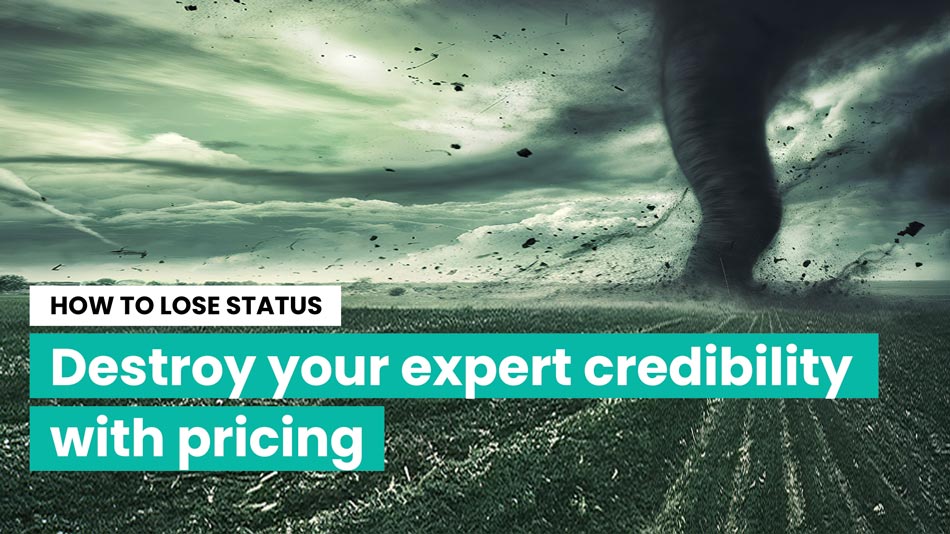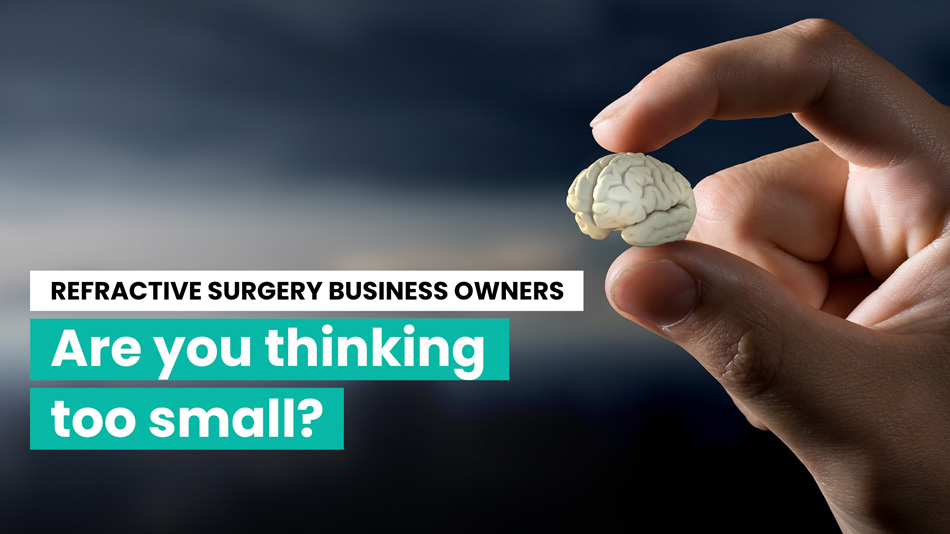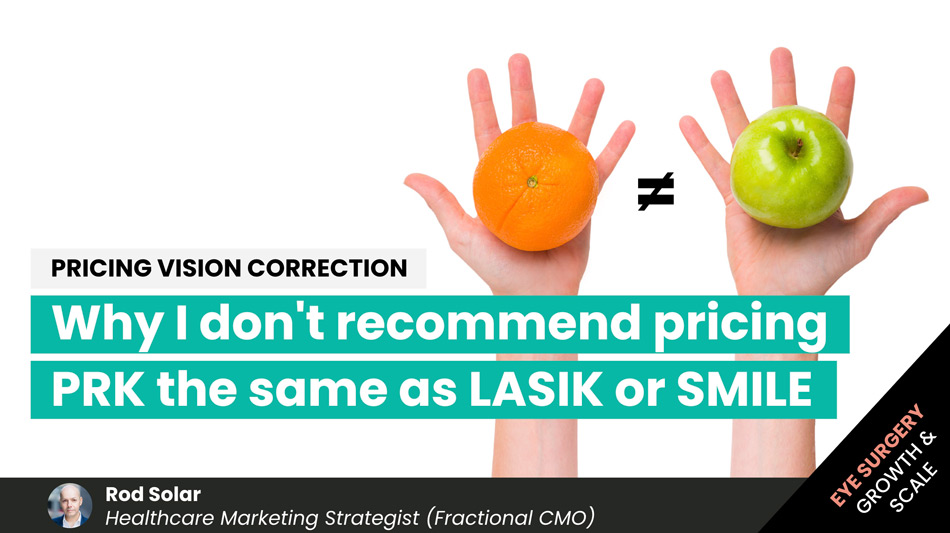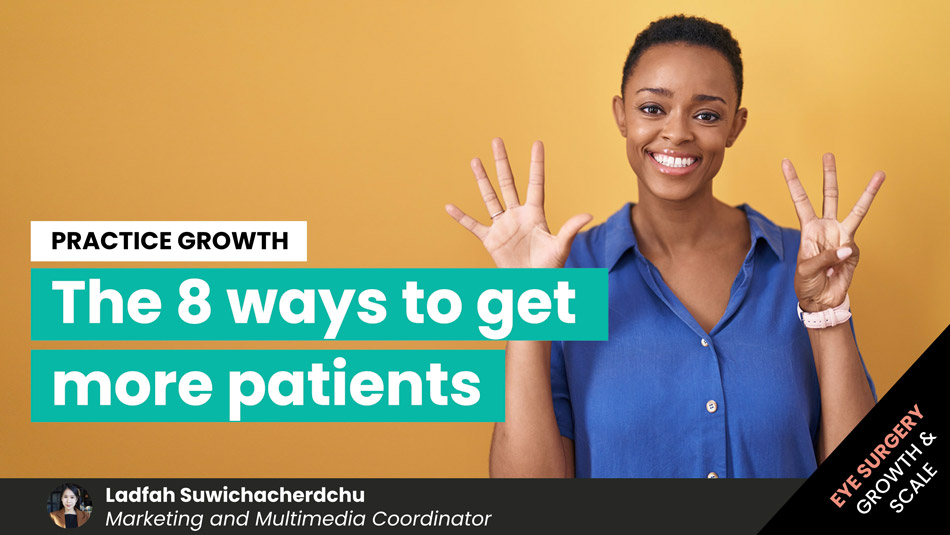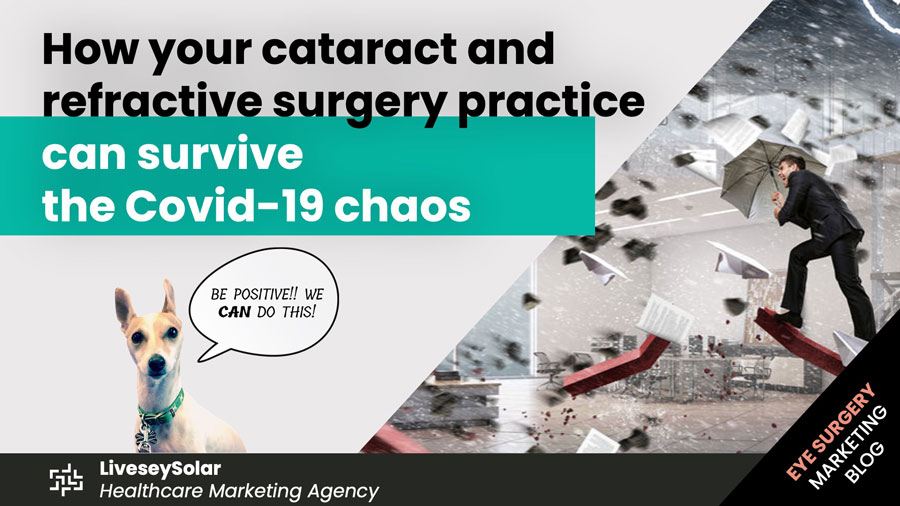
How your cataract and refractive surgery practice can survive the Coronavirus chaos
To our valued clients and colleagues in the medical field: First things first. We sincerely hope that you and your loved ones are doing as well as possible given the current circumstances. We understand that some of you may potentially be called to the front line of this crisis. We are immensely grateful for your service. It is not a stretch to recall the words of Churchill when he said: “Never in the field of human conflict was so much owed by so many to so few.”
If you’re reading this, then it’s clear you’ve got a moment to breathe. You’re taking a proactive approach to understanding the next steps to ensure the survival of your business after the outbreak of COVID-19.
Here is the top-line:
- This too shall pass.
- You can make it
- This could be the moment for which you were made
- We have a plan
- We are going to GIVE it to you, freely, no strings attached
Shortly following the WHO announced a global pandemic, we locked ourselves in a room for two full days to map out the future for our cataract and refractive surgery clients. We resolved to make informed predictions of how the COVID-19 Crisis will impact the elective surgery market in the short- and medium-term and what this could mean for you and your practice, clinic or hospital. Attend this free webinar this Thursday, March 26th and we’ll lay it all out. In the meantime, read this post.
We plan this event to be the first of many. Now is the time to help, to share, and to support each other through this challenge.
As the owner of a private cataract and refractive surgery practice, clinic or hospital, it is likely that you’ve already started implementing special measures to protect yourself, your employees and your patients during this time of considerable uncertainty and concern. We thank and applaud you for that. And while you’ve likely already shut-down, no one could blame you for taking a moment to wonder “What’s going to happen to my business if this goes on for weeks or months?”
Now that you’ve addressed staff and patient safety, which is the most critical concern, we want to turn your attention to the protection of your business. One thing we can be sure of is that the pandemic will impact all of our lives and the entire economic landscape, as we know it, will never be the same again.
(NOTE: Do you want to increase your chances of surviving this Coronavirus chaos? Keep your balance and maintain or even grow amidst worldwide fear, confusion, and uncertainty. Make sure you watch this webinar to discover the framework you need to plan and take action as soon as possible. We hope to reduce any anxiety you have and show you a way to maximise any “extra” time you have right now to navigate the coming storm successfully.)

You probably already know that massive change is here
Our first piece of advice to you is to get used to change. Change is something that we no longer have the luxury of expecting to arrive in small blips that barely ripple our landscape. We hope to convince you with this post that you must do more than simply be psychologically ready for change. To succeed in the coming months, you will need to strategically plan for the expected (and predictable) changes that are coming and then take strong and specific actions to protect and advance your goals.
As the owners of a digital marketing agency that has specialised in elective healthcare for almost 20 years, we have built a life around living on the edge of a forever changing industry.
- In the late 1990s, the arrival of the internet changed marketing as we knew it
- Then, the implosion of the dotcom bubble changed it all over again
- Next came 9/11, then 7/7 and the ensuing “war on terror’
- In 2008 we saw the credit crunch and the beginning of a global recession that saw an entire generation of income inequality
- And now, we have the COVID-19 global pandemic, and again, life will never be the same.
Our experience shows us we only have to blink and there’s something new on the market changing consumer habits and disrupting trends. Now is the time to stay alert, monitor the environment, respond to changes and act deliberately.
Of course, there’s no actual map to follow for this as no one’s been here before. However, we have survived two recessions (and we’ll survive this one too) and are accustomed to drastic changes within our working environment. The phrase ‘survival of the fittest’ has never been more apt.
We strongly believe, whatever your current situation may be, that the time is now to start putting a solid foundation in place to drive your business out of this current crisis to guarantee a happy and prosperous future for yourself and your family.
Below, we have also shared useful information on government support you may be entitled to during this period of disruption. This information changes daily, and we’ll be updating you on social media as we go.
Mindset is everything
Before we introduce you to our phased roadmap about what to expect (and what to do), let’s get into the right mindset. In times of panic and uncertainty, it’s understandable to be confused and even act irrationally; smart moves aren’t typically born from this headspace so before you start to make any decisions consider this critical message:
Don’t react. Respond.
We all have a lizard brain, a monkey brain, and a visionary brain. Be diligent not to stimulate your lizard brain – the one that makes you fight, flight or freeze. Resist the comfortable denial of the monkey brain – this is not the time to blindly do what others do.
Instead, it’s time to stay in your visionary brain as much as you can. It will be hard. The choices you’ve made and will need to make will tax your resolve. Your visionary brain that likely led you to start your practice in the first place. That’s the calm, deliberative, creative, and optimistic brain that asks – “what do I want to see in the world, and how do I want to engineer it?”
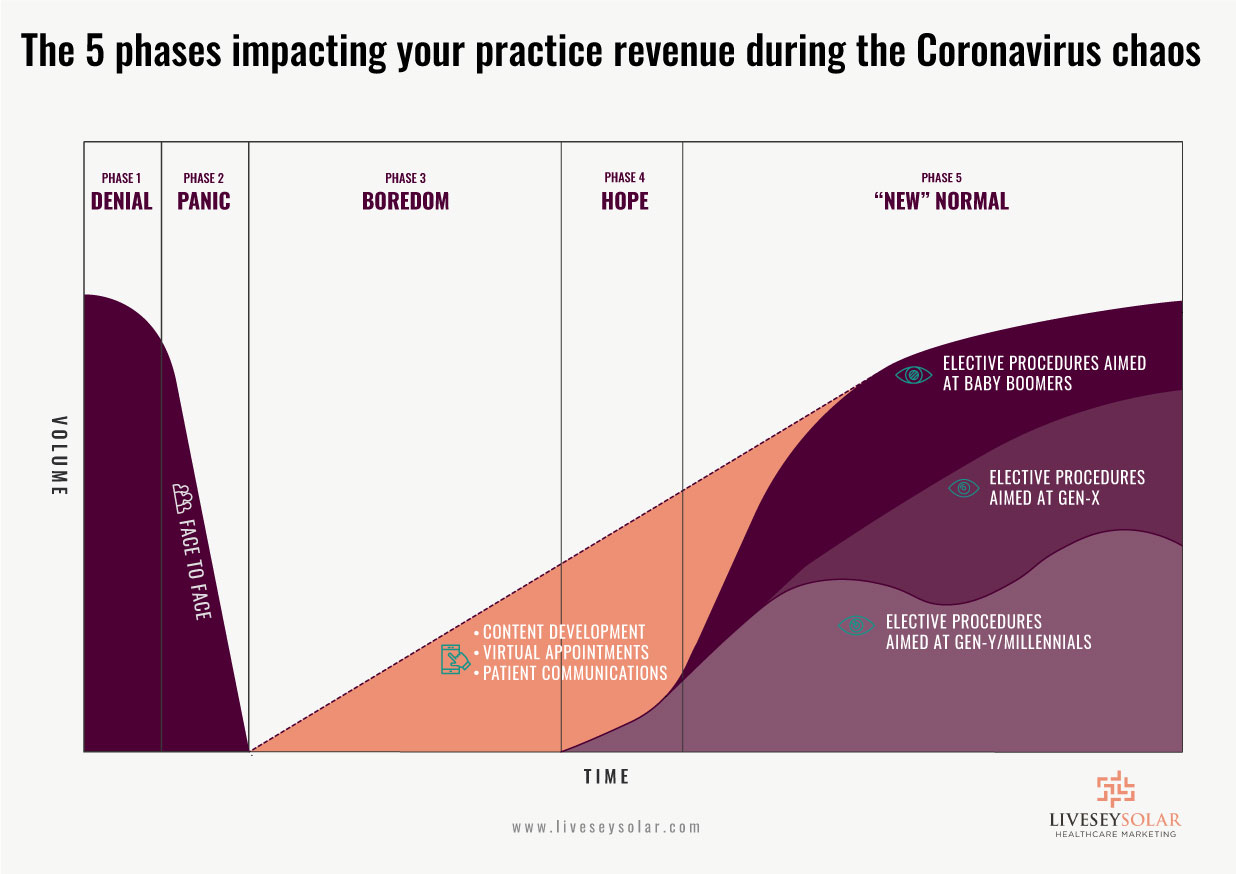
The 5 phases of the COVID-19 crisis, aka ‘what you and your prospective patients are about to experience’
We project a phased trajectory for the COVID-19 crisis and explain what your market will experience and how you should respond in the sections below:
- Phase 1: Denial (1-2 weeks before your shutdown)
- Phase 2: Panic (2-3 weeks of shock)
- Phase 3: Boredom (6-12 weeks after your shutdown – it could be a lot more…)
- Phase 4: Hope (12-16 weeks after your closure)
- Phase 5: The ‘New’ Normal (16 weeks to up to 2 years after your shutdown)
Phase 1: Denial (1-2 weeks before your shutdown)
In the UK and most of North America, we’re mostly past this phase now. Our clients in Australia; however, are just getting started. The chart below illustrates the critical insight that many countries (and in the US’s case, many states) are in a different phase of this crisis at any particular time.
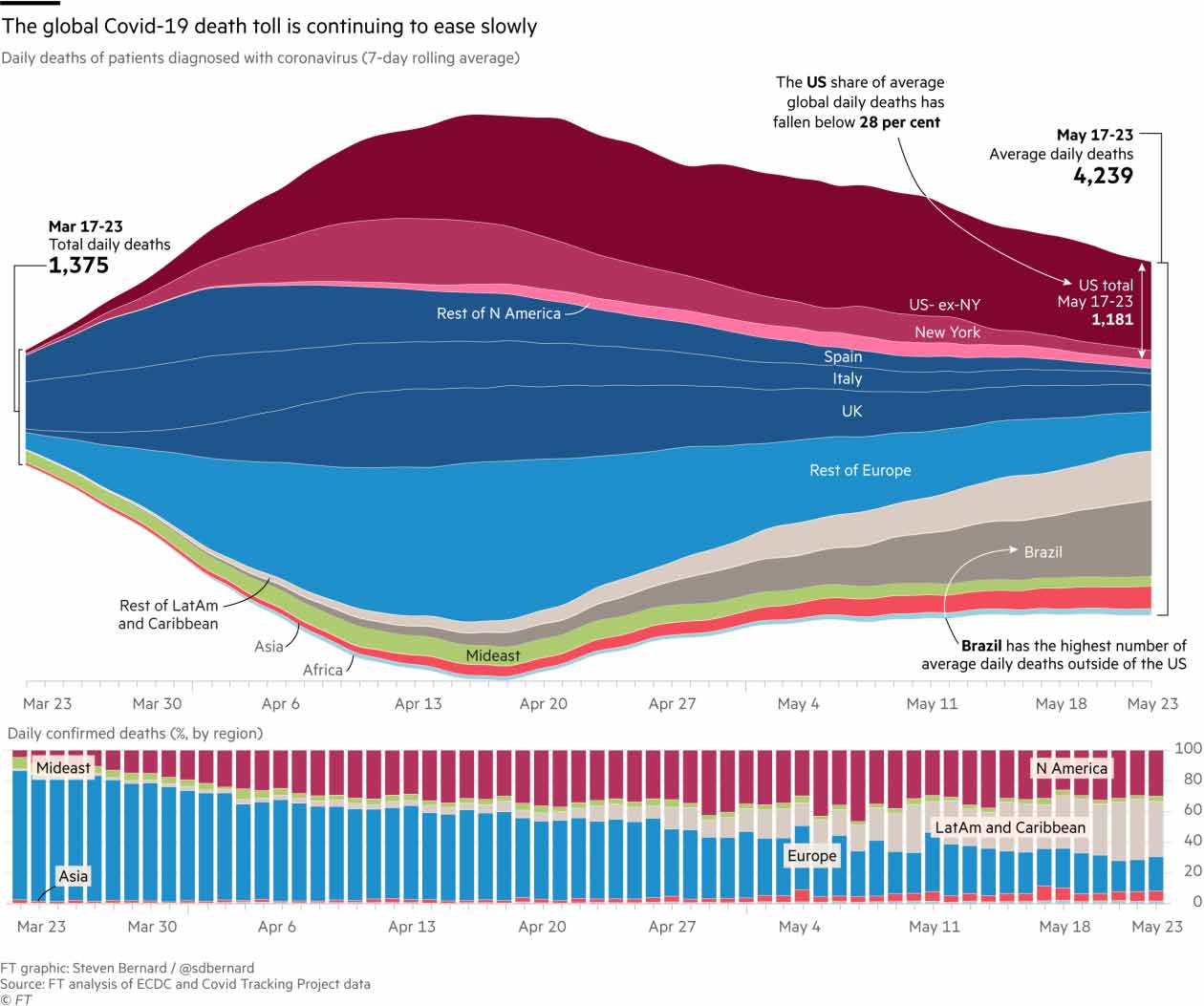
If you’re in one of the countries to the left of the UK in the above chart, COVID-19 is creating significant anxiety. You might even be a little bit in denial – a common place to go for the lizard brain.
If you’re not in denial, you might be surprised that the general public doesn’t seem to be taking this seriously. That’s because these people are in denial and you are not. Despite that, you might be a little hesitant about taking urgent measures (that’s the monkey brain talking).
You may notice that pockets of the population are either unaware of or disinterested in the crisis. The majority, however, likely has it at the forefront of their minds.
In the denial phase, your market is conducting “business as usual”
People are distracted, but they’re carrying on. This group is in full-on monkey-brain mode and is carrying on as they always have done. You see these people in the bars, cafes and restaurants right up until they close. These folks will keep their appointments because, for them, nothing has materially changed. That is the minority, and they’re typically younger Millennials – your LASIK market.
Demand is slowing as many consumers bump elective surgery down their priority lists. Some have flown past denial and now fully tapped into their lizard brain, triggering an immediate reaction that tells them to drop everything and run. They will cancel all their plans, including yours. These people need immediate delay and postponement of their elective surgical appointments for three months hence.
Others are freezing in stasis. These people have put everything on hold and are reluctant to act. They will not show up to any appointments. You need to proactively reach out to these people and let them know that you’ll be there for them after all this blows over – no questions asked.
How future buying decisions will play out will depend on where the prospective patient is on their value journey. Those in the awareness phase who are just beginning their research will likely postpone entirely. Those who are more invested may go ahead with their purchasing plans.
You have an immediate opportunity to help some patients in the denial phase
If your country is in Phase 1, you need to act immediately. The denial phase won’t last for much longer, so you must adapt your message now to optimise your chances of squeezing in some patients before things go pear-shaped. To do this, you must appeal to safety, without fear-mongering and adding to an already unnerving situation.
You may imagine that if everyone knew that a shutdown was imminent that no one would have an interest in refractive surgery. In fact, after speaking to most of my clients in pre-shutdown phases, they report that much of their market considers this stage “business as usual”. One surgeon told me he booked eight eyes on the last day their clinic was open.
The first step you can make is to introduce some new practice protocols. Allowing only one patient into the clinic at a time, isolating in-person appointments, pre-screening to keep anyone suspected positive cases out of the clinic, and implementing diligent cleaning regimes between visits is an excellent place to start.
For those who have not yet booked an initial appointment with you, start offering online appointments immediately. Find out how to get started here.
Immediately send this information to people who’ve already booked surgery, along with guidance on what you’ll do if your patients present with symptoms. That messaging will much reassure them and increase the chances of them continuing with treatment.
Once you have the practicalities in place, you need to appeal to the emotional concerns and lower-level needs of your patients.
- Focus on self-reliance – Convey the message to your customers that they need vision correction to remain self-reliant.
- Focus on safety – Tell them that the process of getting treatment is safer than everyday activities during a pandemic, such as shopping for groceries.
- Allude to perceived shortages of supply – Ask them how they intend to cope if they have a high prescription and break their glasses? Or how they can avoid touching their face when they need to insert and remove contact lenses?
These messages will get them thinking about their situation in the context of COVID-19 so that they convert.
People in both the lizard and monkey-brain might respond to a ‘last chance’ type of messaging. Many people will see this as their opportunity to undergo treatment before the option is taken away from them (perhaps indefinitely). They would love to be able to get their surgery completed, so they feel less vulnerable during the uncertain times ahead once the authorities enforce restrictions on movement.
Most elective surgeons and clinics will have already turned off their paid traffic ads or dramatically lowered their budgets. Do not do that. Pay-per-click is a bidding war, and when ad demand crashes, the value of those clicks significantly diminishes. You can likely get keywords that cost you £10 to £20 for pennies on the pound. Do this, with your new messaging, with as much budget as you can afford. When it’s time to shutdown (or when you have zero capacity available), shut all ads down.
Don’t concern yourself with the cancellation of surgeries. They will happen. Don’t concern yourself with DNA rates. They too, will peak. Do as many operations as you can as safely as you can to shore up income for the lean times ahead.
Phase 2: Panic (2 to 3 weeks of shock)
In the chart below, most of Europe and Australia is already here (red), with the UK leading from behind. North America and Russia are in a partial shutdown. China was here in late January 2020, but note, they are no longer shut-down (grey). The AMO has urged its members to Immediately Stop Routine Surgical and In-Office Visits1https://eyewire.news/articles/american-academy-of-ophthalmology-urges-members-to-immediately-stop-routine-surgical-and-in-office-visits/. The RCOPHTH is asking “most hospitals and eye units … to rapidly draw up plans to reduce or cease some or most elective care including theatre and any urgent care which can be done safely.”2Coronavirus RCOphth update – need to know points
Many health authorities are advocating virtual appointments, and even insurers are covering them.
In the panic phase, your market is putting basic needs first
During this phase, there is an immediate and sudden contraction of supply and demand for elective healthcare services as physiological, and safety needs supersede everything else. Your inquiries will likely slow to ZERO in this phase. People will be preoccupied, worrying about basic physiological needs (health, food, water, sleep, shelter) and safety needs (personal security, emotional security, financial security, health and well-being, safety needs against accidents/illness and their adverse impacts). People must meet these lower-needs before they can act to serve the higher-level needs on the pyramid.
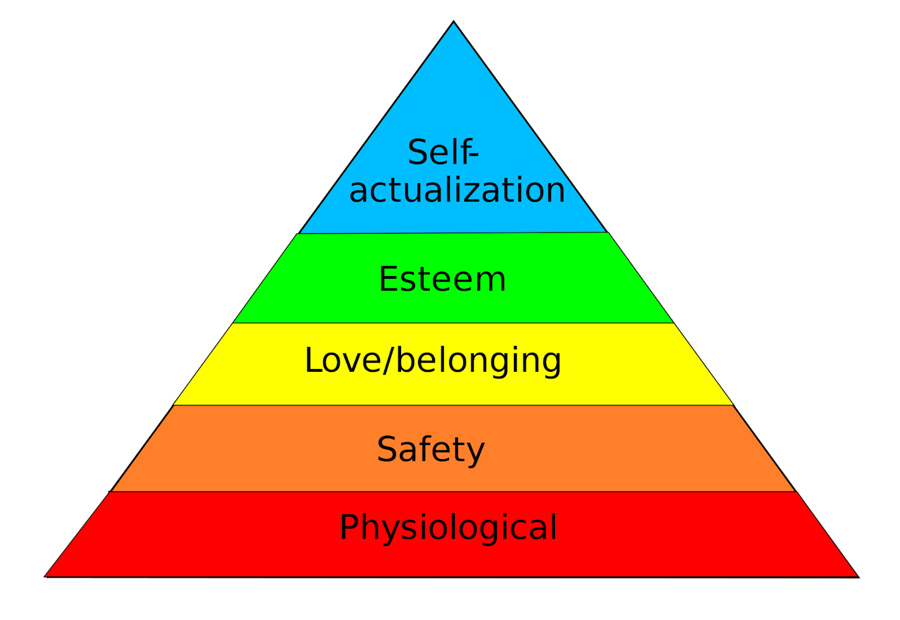
Don’t market to anyone in the panic phase. Start planning for what you’ll do in the next phase now
The key at this time is to prepare appropriately for the next 3 phases.
At this point, any communication with the public should be in the form of a public service announcement (not even remotely hinting of advertising). We advise you to shut off all ads (Google Adwords, Facebook, Instagram and YouTube) to avoid coming across as insensitive or off-topic. Furthermore, any clicks at this moment would be purely educational with very little commercial value.
While you don’t have the patient volume at this time, what you do have is time. One of the most significant challenges we’ve experienced when working with doctors and surgeons is finding enough time to do enough marketing. Doctors rarely can devote sufficient time to either shoot, write, edit, or approve content.
Furthermore, Google is still indexing content that is not related to the global pandemic. Unlike human beings, Google is an entirely rational machine that feeds off any quality content. While your colleagues and competitors are hunkering down, you can use this time to prepare for the future.
Start the planning process by answering these questions:
- How will I continue to generate awareness during the next phase (boredom)
- How can I engage my audience to address some of the problems they’ll experience during the next stage?
- How will I handle any phone calls I might get if I’ve closed down my contact centre or furloughed my medical secretary/receptionist
- How can I build a list of prospective patients so that I can supply their pent up demand in following the next phase?
- How can I convert my prospects so that I can give them hope of a better future after the next phase?
Phase 3: Boredom (6 to 12 weeks after your shutdown)
Phase 3 will be the isolation phase, either mandatory or voluntary. China was able to shorten this phase significantly. Italy, and other European countries, may or may not fare better; the prognosis is not hopeful. The US, due to its resistance to any restriction of individual freedoms, and lack of a public health care system or other vital social safety nets, will likely have the toughest time with this phase.
In the boredom phase, your market is starving for interaction, education and entertainment
Many people will continue to work from home. It’s essential to note that (some of) their income will likely continue to the degree that their companies do not depend on the service sector. If your market tends to be composed of white-collar workers, business to business, professional sales, marketing and other office professionals who primarily work from internet-enabled computers, then they will be able to work remotely from home. In most urban areas, many refractive surgery patients tend to be in these relatively highly-paid professions.
Others who cannot work from home (service sector workers especially in hospitality, tourism, transportation, entertainment, leisure, food services, personal services and other sectors that depend on life going on as usual) will spend much of their time supervising children or tending to vulnerable relatives. At the time of writing, AP reports that 70,000 people have already claimed unemployment insurance in the US3Jobless claims jump by 70,000 as virus starts to take hold. Treasury Secretary Steve Mnuchin has already said that unemployment rates could reach 20% (it was 3.5% before this crisis).
People will be hungry for information and entertainment that distracts them from current events and the sheer monotony of life inside four walls.
People who can work at home will be best off. They will maintain a sense of normalcy that arises from a routine schedule, working, and even socialising with friends and family online. They’ll have access to streaming video and games and will likely also be able to maintain exercise routines and eating habits.
Those who have difficulty adjusting to childcare, whether they have jobs or not, will have a very hard time. Those who have at best cordial relationships with their immediate family will experience difficulty. Those who do not have jobs will not fare as well. For some, this will be a season of boredom, for others, it will be trying in many other ways.
Now we are getting to the psychological effects of quarantine, which researchers have studied extensively. The Lancet
“did a Review of the psychological impact of quarantine using three electronic databases. Of 3166 papers found, 24 (were) included in this Review. Most reviewed studies reported negative psychological effects including post-traumatic stress symptoms, confusion, and anger. Stressors included longer quarantine duration, infection fears, frustration, boredom, inadequate supplies, inadequate information, financial loss, and stigma. Some researchers have suggested long-lasting effects.”4 PDF [247 KB]Download PDF
Your potential patients need you in the boredom phase – Educate and entertain them in an interactive way
At the boredom phase, create and disseminate content that is either informative, educational or entertaining, while maintaining a sensitive tone to current affairs – less aspirational, more grounded in utility. Most importantly, make this content interactive.
This time is the time for list-building, not selling. If you took our advice above to develop content assets and lead magnets during phase 2, you’re now ready to interact with potential patients now, during phase 3, and keep them excited about what you offer.
Remember this: The lack of ability to get what you offer does not remove the desire for that want. Let me say that again because it’s imperative. The desire for what you want persists and will continue to persist through the end of this crisis. As long as your potential patients have a problem, you can solve, then the desire is still there to solve that problem.
Unless your government has seconded you to the front-lines, you have the luxury of time right now – use it productively to:
Develop content
- Get busy creating an abundance of quality written content that helps your prospective patients cope with what they’re going through
- Start creating home-made video content. Even if you wanted to, you’d be unable to concern yourself with high production value. Don’t worry about perfection here. Everyone is in the same boat – go home-made
- Update your website content to get more in touch with what’s happening now
- review your messaging and your calls to action – are they in tune with the current reality of self-isolation?
- Optimise your site for search. Remember, Google isn’t distracted; it’s still working!
- Reconsider your imagery – perhaps showing people what they can’t do right now isn’t sensitive to the current reality
- Focus your content on the top-of-the-funnel, this is the time to build your audience, not to make sales
- Consider running a weekly webinar and remember to dole out guidance on how to deal with your prospective patients’ concerns in general, not just around what you do
- Start pivoting your content away from Millennials to attract these markets:
- Generation Xers (they’ll still have some spending power)
- Baby Boomers (they have more wealth so will be less affected by the economic downturn)
- For content ideas: Imagine everything that might help the problems these people have:
- Are they spending more time on screens? (yes)
- Are they having a tough time replenishing contact lenses? (yes)
- Are they unable to fix or purchase new glasses should they need to do so? (yes)
- Do they have ample time to recover (and even look bad for a while – if you offer cosmetic procedures) in the comfort of their own homes (yes)
- Are they worried about personal safety and would they like to free from the need to use visual aids during an emergency (yes)
Offer virtual appointments
- If you haven’t yet enabled online appointments, do so now – all you need is Calendly and Zoom – we show you how here
Get a ‘pay-per-call’ phone answering service
- A note on the phone, people may still want to call you. This might be especially true for people who’ve had post-ops with and want to speak to someone. We recommend identifying a pay-per-call phone answering services that you can rely upon to give your patients and prospective patients a voice on the end of the line. If you’re in the UK, we can help you with this starting right now. Set up a compatability call with Laura for more information.
Write and shoot patient communications
- Reconsider your messaging in all automated emails – are they offering the right call-to-action? Or are they tone-deaf to the current reality?
- After your virtual appointments, you’ll need to send automated emails to keep people excited about what they can look forward to in the new normal – write them now.
Reposition your brand and offering
- If you’re not in the sub-premium or premium end of the market yet:
- Update your website to re-position yourself as a luxury service. What? Update your site now? Yes, I’ll explain below
- Upscale your premises to position yourself as a luxury service
- Model how much you need to increase your prices to make up for your losses in the lean time.
Phase 4: Hope (12 to 16 weeks from your shutdown)
Bill Gates famously predicted this global pandemic in a 2015 TED talk 5Bill Gates warned us of a COVID-19-like pandemic — watch his TED Talk from 2015 that’s since gone viral. In it, he tells us we could be out of this in a couple of months, depending on the severity of the crisis and how governments and how people respond.
In an AMA on Reddit, he wrote: “China is seeing very few cases now because their testing and shutdown was very effective. If a country does a good job with testing and shutdown, then within 6-to-10 weeks, they should see very few cases and be able to open back up,” Gates wrote. 6 5 Key Insights on Coronavirus From Bill Gate’s Reddit AMA
With the announcement that China has reported zero new local COVID-19 7 China has reported zero new local COVID-19 cases cases for the first time since the outbreak began, they have arrived at the end of the tunnel.
Your market is now hopeful and planning their next steps once freedom returns to their lives
After 12 to 16 weeks from your shutdown, we will be through the worst of it, and people will begin planning for their future. We expect that many will have a new sense of purpose and direction as well as a feeling of relief and gratitude for having made it through this tough time.
No one knows precisely when consumer and business confidence will recover. There will likely be steep economic decline followed by a period of bumping along the bottom, like an aeroplane, struggling to take off. There will be an economic recovery – but it’s going to take a considerable amount of time.
Don’t expect business as usual – focus your marketing on the affluent Gen-Xers and Boomers
At this time, there will be significant economic impacts. But this is important: not everyone experiences economic effects evenly. While the most at-risk population for COVID-19 casualties will be Baby Boomers and Traditionalists, Millennials will suffer the most profound economic impacts. Generation X-ers and Baby Boomers will become the most significant affluent segment of the population.
What’s going to happen with elective procedures that are popular among Millennials and Gen-Y?
As they enter their prime earning years, Millennials will struggle to make it into a shrinking middle class. They will, almost definitely, become the first generation to end up worse off than their parents. Crippled by student debt in some parts of the world and lower earnings (everywhere), millennials will be shut out of the housing market, thereby losing the most reliable access to building wealth. Their trajectory, already dreadful, will become worse. It’s horrible to write it, but chances are the only Millennials that will likely see wealth (if they haven’t already seen it) are the ones that will inherit it from their parents and grandparents who pass. And, there will be a significant amount of additional deaths in those over 70.
So, what to do now?
Understand that luxuries are recession-proof
While the word ‘luxury’ can be synonymous with ‘unnecessary’ – let’s face it, when most people barely are making ends meet, that’s what refractive surgery is.
Hear me now and quote me later – this recession will likely mark the end of elective surgery as a commodity. Position it as a luxury and adjust your service-level accordingly. Think about it: How will high-volume work in a social distancing environment that might last anywhere from six to twelve or eighteen months? It simply cannot.
The affluent have high discretionary income even when consumer confidence is low. As they emerge from their quarantine, this will be the time to raise your prices to match your social distancing requirements.
Unless your country takes a herd immunity strategy, there will still likely be the significant talk of re-infection and a “second wave” of infection. Therefore, we recommend you offer fewer but higher quality, 1-at-a-time visits. Ramp these up slowly while you can, using the incremental margin of your raised prices to pay for the reduction in volume.
Continue with online consultations. No matter how safe you feel your environment is, people who’ve avoided restaurants for two months aren’t about to go out for dinner twice a week. Once people realise how easy and efficient virtual appointments can be, they will demand them as part of the patient onboarding mix.
Now is the time to start advertising again, aggressively. Think of driving out of a curve, accelerate while everyone else tepidly comes out of it. Send traffic to your content, to your lead magnets, and your online consultations. Pay as much as you can afford for your traffic because surviving the next year now depends on it.
At this phase, you’ll want your marketing material to contain messages related to independence, self-reliance and self-improvement. People will be looking to improve their quality of life and fortifying themselves for the next existential threat.
Phase 5: The ‘new’ normal (4 months from your shutdown up to 2 years)
If you’re reading this blog post, you’re likely someone who is deeply involved in the medical profession. Therefore, you are likely profoundly aware of what’s coming on a societal level. I know that I don’t need to waste your time giving you the math on this. You know what’s going on and you see how this is likely going to play out.
If we don’t get our response right, it’s going to be an even more significant population reduction event than World War II. If we’re smart and lucky, we might come out moderately less damaged than the 1918 influenza pandemic.
What are the effects of such a sharp decline in a population? On the negative side of the equation, we’re going to have a significant global recession and a considerable strain on mental health. Grief will be ubiquitous. There are no words to express the loss of what’s to come, even in our best-case scenario.
A few upsides
Yet, there isn’t such a thing as a one-sided coin. While it might sound insensitive to state it, there will be some undeniable upsides. What will they be?
- A decrease in the dependency ratio. Because most mortality will be in the older population, there will be fewer people dependent on the tax and entitlements generated by workers
- A reduction in the need for end-of-life care for the elderly
- A better prognosis for funding entitlement programs
- An increased GDP and income per capita which is a proxy for living standards
- Environmental benefits as a result of lower motorised traffic, less ecological destruction, reduced carbon emissions, reduced pollution, etc.
- Lower competition for resources – lower real estate prices, oil and commodity prices
History buffs will note that our last major economic boom was post-World War II, also known as the “Golden Age of Capitalism”. While that may not be good news for the climate; if we’re sufficiently shocked into the realising that we are a delicate species that can be brought to its knees by a microbe, we might begin to take the threat of climate change seriously.
Social distancing – get used to it
In February, I’d only read the phrase “social distancing” once. Now, it’s everywhere. And unless experts’ most optimistic models come to pass, we should expect to be subject to social distancing measures (if not “stay-at-home”) measures anywhere from 12 to 18 months. These may be constant or they may be intermittent. Either way, social distancing will change the cataract and refractive surgery landscape for the foreseeable future.
Consider a typical reception/waiting room that’s about 7×7 metres (23×23 feet) with 32 chairs all neatly placed together – set mere inches apart. Now take those chairs and distance them by 6 feet/2 metres each – in every direction. Now, in a space you could fit 32 people, you can only fit 9 chairs. Your reception room capacity has just reduced by 72%.
Thankfully, you’re not alone
Gov.uk has recently announced that the Chancellor has set out a package of temporary, timely and targeted measures to support businesses in the UK through this period of disruption caused by COVID-198COVID-19: support for businesses . In the US, your guidance to small business loan resources is here.9Coronavirus (COVID-19): Small Business Guidance & Loan Resources
Attend our webinar to start putting together a solid plan to protect your business from the effects of the Coronavirus crisis
When you hear the word recession, we want you to hear the word reinvention!
Believe it or not, this is an opportunity for significant growth – if you play it right. Start preparing now, and you’ll be able to get through this, and could even come out the other side more robust and more profitable.
PS. Want to survive this Coronavirus chaos? Keep your balance and maintain or even grow amidst worldwide fear, confusion, and uncertainty. Make sure you watch this webinar to discover the framework you need to plan and take action as soon as possible. We hope to reduce any anxiety you have and show you a way to maximise any “extra” time you have right now to navigate the coming storm successfully.
NOTE: The best way to answer that nagging question about practice growth or marketing or patient volume in the back of your mind is to book a free 15-minute compatibility call. Get some options and go away with a clear idea of what’s possible.
About the author

LiveseySolar
LiveseySolar’s mission is to double the size of 150 cataract and refractive surgery practices. Using our proven marketing frameworks and deep market knowledge, our customers can predictably and sustainably grow their practices so that they can enjoy a healthy balance between both worlds – a successful private practice and a happy life.
Related Posts
Meet our Co-Founders
We’re passionate about helping leaders of high-quality, growth-minded practice owners double their practice revenue
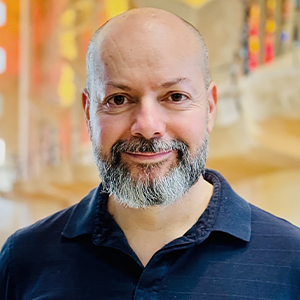
Rod Solar
Founder & Scalable Business Advisor
For over 20 years, I’ve helped ophthalmology entrepreneurs scale their private practices. I specialise in doubling revenue within three years by offering a proven framework, hands-on experience, and a team of experts who implement what works. We take the guesswork out of growth and scale, so you can focus on delivering exceptional patient care while maximising the value of your business.
LiveseySolar completely transformed the way we were approaching this… We’ve gone from having just the dream of having a practice to having a practice up and running with people making inquiries and booking for procedures… It’s extremely pleasing. We feel lucky we connected with LiveseySolar.
— Dr Matthew Russell, MBChB, FRANZCO, specialist ophthalmic surgeon and founder of VSON and OKKO

Laura Livesey
Founder & CEO
I’m the co-founder & CEO of LiveseySolar. I’ve developed powerful eye surgery marketing systems that increase patient volumes and profits for doctors, clinics, and hospitals, since 1997.
Rod and Laura know as much about marketing surgery to patients as I know about performing it. They are an expert in the field of laser eye surgery marketing. They know this industry inside out. I believe that they could help many companies in a variety of areas including marketing materials, sales training and marketing support for doctors.
— Prof. Dan Reinstein, MD MA FRSC DABO, founder of the London Vision Clinic, UK












